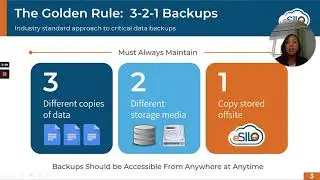3 Signs It's Time to Upgrade Your Backups
Are you still backing up data manually? Could your backups be missing important information? Could a hacker find your backups and corrupt or destroy them?
If yes, these are definite warning signs and it's time to upgrade your backups.
If you've seen any of my content on YouTube or social media, you've probably heard me stress the importance of good data backups. Whether you've lost or overwritten an important file, or you need to recover from a ransomware attack, a good set of backups will ensure that you don't lose any information.
When you have a modern set of backups you know that any IT disaster can be quickly averted with only minimum downtime and disruption to your operations. If your data is ever held hostage for a ransom by a cyberattacker, you know you never have to pay to get your information back.
But when was the last time you checked on your backups? A lot of business leaders have a set it and forget it mentality when it comes to their IT systems. They setup a backup once, and then it's weeks, months, or even years later before they go and check on that backup. Usually when they need to recover something.
But studies have shown that up to 58% of backups are unable to be recovered either because of an issue with the backup itself or an error in the recovery. So it's worth looking at your backup software to make sure it's modern and current, and that your backup strategy and processes are resilient and not prone to error.
The first sign that it's time to upgrade your backups is going to be if any part of what you're doing is manual. If someone has to remember to attach a USB drive, or to swap out different tapes, or to click a button to start the backup, it's only a matter of time before one of those manual processes gets forgotten.
This is especially true when the person responsible for your backups is not in IT. Because this is not their core responsibility, when they change jobs or leave the company, it's often forgotten. (This is one reason why it pays to have an outside company monitor your backups on your behalf, and alert you to any problems, which is what we do at eSilo).
Unfortunately, too many companies realize they have a problem with their backups when they go to restore data, only to find that the backups haven't been running since Sally left the company six months ago.
With today's software, there are so many advanced ways to automate every aspect of the backup process from scheduling to testing and alerting on those backups. There's really no reason to stick with manual processes anymore.
The second sign that it's time to upgrade your backups is if you're using an older, traditional style of backup which is file-based. With a file-based backup, you as a user (or your IT person) needs to define the population of files to be captured in the backup. As you add new data over time, you have to constantly update those backup plans to ensure that all important data is included in the backup. I have seen many companies fail because they forgot to do this simple step.
File backups were great for space savings when storage was expensive, but nowadays, to get the fastest recovery, what you want is a full image backup. A full image backup takes an image of the hard drive. It protects all the information on the machine without any human intervention or manual review, and it's the most foolproof way to protect the information on your systems.
The third sign that it's time to upgrade your backups is if they're not protected from corruption or deletion by hackers or disgruntled employees. One of the most common tactics among ransomware gangs is that once they infect a machine but before they start encrypting data, they do reconnaissance. And one of the first actions they take is to attempt to disable and destroy any existing backups they can find on the system or the network.
If you're not alerted to unusual backup activity in real-time, and you're one of the many businesses that employ a set it and forget it mentality, this is an early warning sign that you can easily overlook.
According to the 3-2-1 Rule, which is an industry-standard for backups and data protection, you should be saving three copies of important data (main copy + 2 backups), on at least two different types of storage media (USB, cloud, etc.) with one of those copies, being saved both offsite and off-network.
That last one is really important because if you have your backups stored locally within your network it may be accessible to hackers. A good offsite copy is going to be protected by a separate set of login credentials, making it more difficult for an intruder or malicious insider to gain access.
Today's modern backup solutions can address many pitfalls that older software and practices simply can't. If you'd like to have a conversation about how to protect your systems and information from loss, theft, or corruption, I invite you to a free chat. To schedule, go to MeetCathy.com.





![Baaje Khatiya Char Char [Bhojpuri Video]Feat.Ravi Kishan & Pakhi](https://images.videosashka.com/watch/We4oVHR1Yxw)













